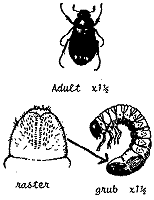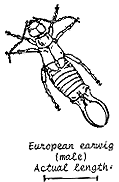|
|
|
DESCRIPTION: INJURY:
|
During the months of June and July, adult beetles emerge from the ground at about 8:30-8:45 p.m. EDT and take off in mating flights. The mating flights consist of many individuals and have been described "to sound and look like a swarm of bees." The flights occur at sunset - enormous numbers of beetles swarm about a tree or tall shrub, or even sometimes a chimney, for about 30 minutes and the settle down on the foliage where mating occurs. The adult beetles do not feed and they do not bite or sting. They may, however, tear plant foliage as they attempt to hold on with their spiny legs.
The following day females will burrow into the soil a few inches
and deposit eggs in earthen cells. Generally they lay 20-30 eggs,
depositing them singly in cells. In two to three weeks, the eggs
hatch and the tiny grubs begin feeding. By fall the grubs are in the
3rd instar. The following spring, as soils begin to warm, the grubs
again come toward the surface and feed. The pupal stage occurs during
last May and early June. During this stage the insects do not feed.
Most European chafers have a 1 year life cycle, but some may take 2
years to complete development.
Back to Pest Information
|
Forficula auricularia Linnaeus |
|
|
INJURY: In addition to their feeding activities, earwigs often occur in close proximity to people, even getting into houses and garages, especially during periods of very wet weather. In the home they are attracted to paper and fiber products stored in moist situations and thus may be found in basements, kitchens, and occasionally in bathrooms. DESCRIPTION: |
The adult is about 19mm (3/4") long, a somewhat flattened elongate insect, dark red-brown in color with short wing covers. It seldom flies. The young are similar to the adults, gray-brown in color, and lacking wings. The most distinctive feature of earwigs is the pair of forceps on the tip of the abdomen. On the male the forceps are strongly curved, in the female they are nearly straight.
LIFE HISTORY:
The female earwig deposits up to 300 white, nearly spherical eggs in
a cell in the soil at a depth to 15mm. Depending on temperature,
incubation lasts from 12 to 85 days, eggs laid early in the spring
requiring the longest to hatch. The female guards the eggs and newly
hatched young, but abandons the brood after the first molt. Nearly a
year is required for development, and there is one generation per
year. Both eggs and young require moisture although heavy rains are
not tolerated. The adults can survive extended periods of
dryness.
Back to Pest Information

|
This site is developed and administered by Lake Technology Solutions, Inc. | www.LakeTS.com | (888) 332-8082 |

